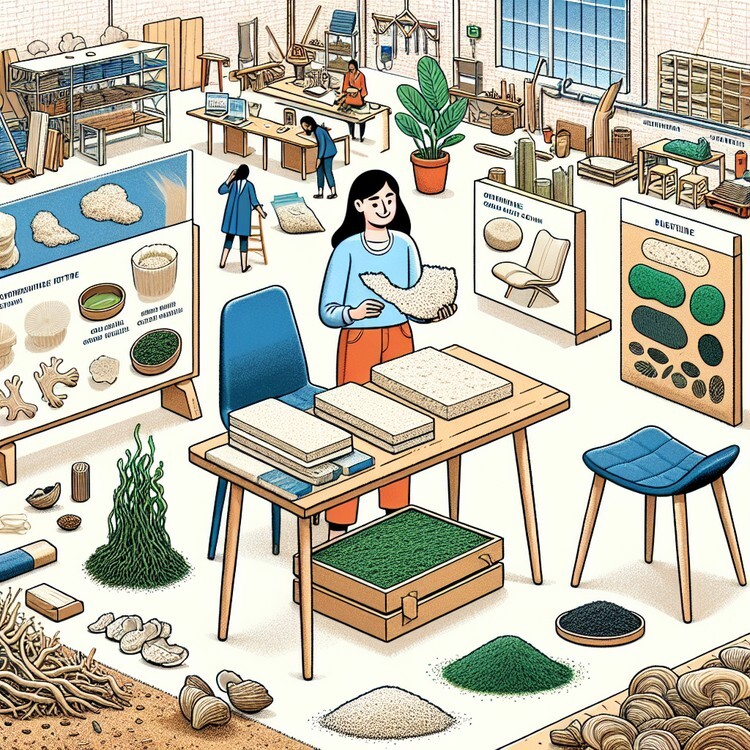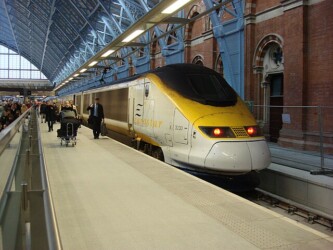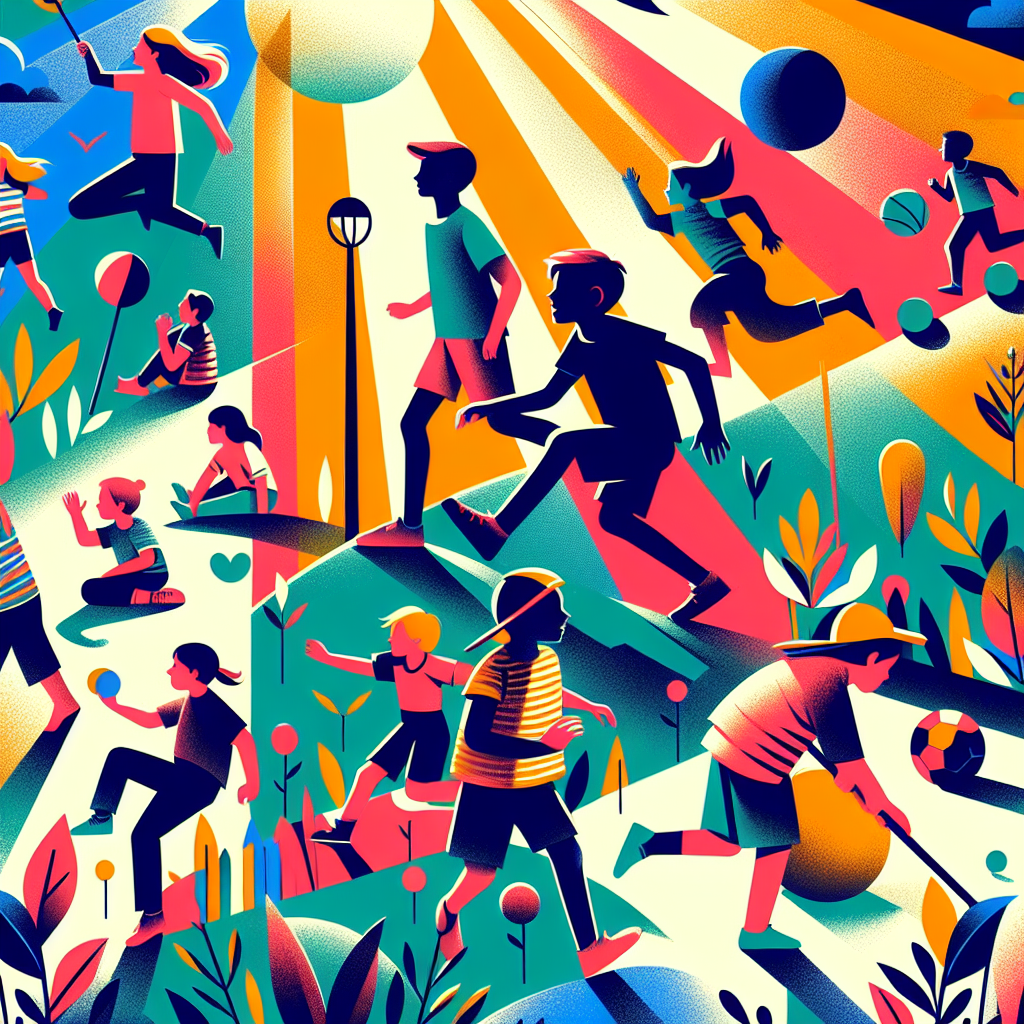Celine Sandberg, the founder of a company called Agoprene in Oslo, is trying out different materials to make eco-friendly furniture. She wants to reduce the use of plastic in making things like pillows and cushions. Sandberg and her team have tested materials like crushed oyster shells, leftover plant stuff, and wood fibers. They found that seaweed can be turned into a soft foam that’s good for seat cushions and chairs. This seaweed foam is 100% biodegradable and will break down in the soil within eight months.
Plastic is commonly used in making furniture because it’s cheap and can be shaped in many ways. But there are big problems with using plastic. In the US alone, 12 million tonnes of furniture were thrown away in 2018, and most of it ended up in landfills. Plastic takes hundreds of years to break down there. Making just one type of plastic foam releases a lot of CO2, a harmful gas that contributes to climate change.
To solve these problems, many companies are looking for different materials to make furniture. One company called Mater uses coffee bean shells and sawdust to make seats and backrests for chairs. They also use waste from the ocean to make outdoor furniture. Another idea being explored is using fungus. Scientists have made a fabric called BioKnit from the roots of fungi. This fabric breaks down naturally and doesn’t need glue or other things that stay in landfills.
Big furniture brands like Williams Sonoma and IKEA are also using more sustainable materials. Williams Sonoma now uses cotton and polyester that are made responsibly or recycled. IKEA plans to only use materials that can be made again or are already recycled by 2030. Sandberg is happy that the furniture industry is trying new things and making changes. She thinks this will help reduce waste and make things better for the environment.
Original news source: The weird materials behind sustainable furniture (BBC)
Listen:
Slow
Normal
Fast
Vocabulary:
| 1 | eco-friendly | Good for the environment |
| 2 | plastic | A material that is not good for the environment and takes a long time to break down |
| 3 | biodegradable | Able to be broken down naturally by the environment |
| 4 | landfills | Places where garbage is buried in the ground |
| 5 | CO2 | A harmful gas that contributes to climate change |
| 6 | sustainable | Able to continue for a long time without causing harm to the environment |
| 7 | responsibly | In a way that is careful and doesn’t cause harm to the environment |
| 8 | recycled | Made from things that have been used before |
| 9 | fabric | A type of cloth or material |
| 10 | waste | Things that are not needed and thrown away |
| 11 | industry | The business of making and selling furniture |
| 12 | reduce | To make something smaller or less in size or amount |
| 13 | furniture | Things like chairs, tables, and beds that you use in your home |
| 14 | materials | The substances or things that are used to make something |
| 15 | environment | The natural world and the surroundings in which living beings exist |
Group or Classroom Activities
Warm-up Activities:
– News Summary
Instructions: Divide the class into small groups. Assign each group a different aspect of the article (e.g. Celine Sandberg and Agoprene, materials like seaweed foam, problems with plastic, other companies using sustainable materials, future plans of Williams Sonoma and IKEA). In their groups, students should discuss and summarize their assigned aspect in a news article format, including the most important information. After a few minutes, each group can share their summary with the class.
– Word Association
Instructions: Write the word “furniture” on the board. Have students take turns saying a word or phrase that is related to furniture. Once a word is given, the next student has to come up with a word that is related to the previous word. For example: furniture – chair – cushion – pillow – foam, etc. This activity helps students practice vocabulary and generate ideas related to the topic.
– Opinion Poll
Instructions: Prepare a list of statements related to the article, such as “Using sustainable materials in furniture production is important for the environment” or “Plastic furniture should be banned”. Divide the class into pairs or small groups. Have students discuss each statement and express their opinions. They can then conduct a poll within their group to see how many people agree or disagree with each statement. Afterward, groups can share their findings and discuss the reasons behind their opinions.
– Synonym Challenge
Instructions: Write a list of words from the article on the board, such as “reduce, materials, plastic, cushions, biodegradable, furniture, landfills, sustainable”. Divide the class into pairs or small groups. Give each group a few minutes to come up with as many synonyms as possible for each word. The group with the most synonyms at the end wins. This activity helps students expand their vocabulary and learn different ways to express the same idea.
– Future Predictions
Instructions: In pairs or small groups, have students discuss and make predictions about the future of furniture production and sustainability. Encourage them to think creatively and consider possible advancements, challenges, and changes that may occur. Afterward, groups can share their predictions with the class and discuss the feasibility and potential impact of each prediction.
Comprehension Questions:
1. What is Celine Sandberg trying to do with her company Agoprene?
2. What are some of the materials that Sandberg and her team have tested for making eco-friendly furniture?
3. Why is plastic commonly used in making furniture?
4. What are the problems with using plastic in furniture production?
5. What are some alternative materials that other companies are using to make furniture?
6. How is Mater using coffee bean shells and sawdust in furniture production?
7. What is BioKnit and how is it made?
8. What are some sustainable materials that big furniture brands like Williams Sonoma and IKEA are using?
Go to answers ⇩
Listen and Fill in the Gaps:
Celine Sandberg, the (1)______er of a company (2)______ Agoprene in Oslo, is trying out different materials to make eco-friendly furniture. She (3)______ to (4)______ the use of plastic in making things like pillows and cushions. Sandberg and her team have tested materials like crushed oyster shells, leftover plant stuff, and wood fibers. They found that seaweed can be turned into a soft foam that’s good for seat cushions and chairs. This seaweed foam is 100% biodegradable and will (5)______ down in the soil within eight (6)______.
(7)______ is commonly used in making furniture because it’s cheap and can be shaped in many ways. But there are big problems with using plastic. In the US alone, 12 million tonnes of furniture were thrown away in 2018, and most of it ended up in (8)______. Plastic takes hundreds of years to break down there. Making just one type of plastic foam releases a lot of CO2, a harmful gas that contributes to climate change.
To solve these problems, many companies are (9)______ for (10)______ materials to make furniture. One company called Mater uses coffee bean shells and sawdust to make seats and backrests for chairs. They also use waste from the ocean to make outdoor furniture. Another idea being explored is using (11)______. (12)______ have made a fabric called BioKnit from the roots of fungi. This fabric breaks down naturally and doesn’t need glue or other things that stay in landfills.
Big furniture brands like Williams (13)______ and IKEA are also using more (14)______ (15)______. Williams Sonoma now uses cotton and polyester that are made responsibly or recycled. IKEA plans to only use materials that can be made again or are already recycled by 2030. Sandberg is happy that the furniture industry is trying new things and making changes. She thinks this will help reduce (16)______ and make things better for the environment.
Go to answers ⇩
Discussion Questions:
Students can ask a partner these questions, or discuss them as a group.
1. What is Agoprene and what are they trying to do?
2. How do you think using eco-friendly materials can help the environment?
3. Do you think it’s important to reduce the use of plastic in making furniture? Why or why not?
4. How would you feel if all furniture was made from sustainable materials?
5. Do you think it’s a good idea to use seaweed foam for seat cushions and chairs? Why or why not?
6. What are some problems with using plastic in furniture production?
7. How do you think using coffee bean shells and sawdust to make furniture can help the environment?
8. Do you think using fungus to make fabric is a good idea? Why or why not?
9. Why do you think big furniture brands like Williams Sonoma and IKEA are using more sustainable materials?
10. Do you think it’s important for companies to make changes to reduce waste? Why or why not?
11. How do you think using sustainable materials in furniture production can benefit society?
12. Do you like the idea of using materials that can be made again or are already recycled? Why or why not?
13. How would you feel if all furniture was made from biodegradable materials?
14. Do you think the furniture industry should continue to explore new materials and make changes? Why or why not?
15. What do you think the future of furniture production will look like?
Individual Activities
Vocabulary Meanings:
Match each word to its meaning.
Words:
1. eco-friendly
2. plastic
3. biodegradable
4. landfills
5. CO2
6. sustainable
7. responsibly
8. recycled
9. fabric
10. waste
11. industry
12. reduce
13. furniture
14. materials
15. environment
Meanings:
(A) The substances or things that are used to make something
(B) The business of making and selling furniture
(C) Able to be broken down naturally by the environment
(D) Things like chairs, tables, and beds that you use in your home
(E) A material that is not good for the environment and takes a long time to break down
(F) A harmful gas that contributes to climate change
(G) Able to continue for a long time without causing harm to the environment
(H) Things that are not needed and thrown away
(I) Places where garbage is buried in the ground
(J) The natural world and the surroundings in which living beings exist
(K) A type of cloth or material
(L) Made from things that have been used before
(M) Good for the environment
(N) In a way that is careful and doesn’t cause harm to the environment
(O) To make something smaller or less in size or amount
Go to answers ⇩
Multiple Choice Questions:
1. What is Celine Sandberg trying to achieve with her company Agoprene?
(a) Increase the use of plastic in furniture making
(b) Use only recycled materials in furniture making
(c) Make furniture more expensive
(d) Reduce the use of plastic in furniture making
2. Why is plastic commonly used in making furniture?
(a) It is expensive and difficult to shape
(b) It is biodegradable and good for the environment
(c) It is cheap and can be shaped in many ways
(d) It releases a lot of CO2, which is good for the climate
3. How long does it take for plastic to break down in landfills?
(a) Eight months
(b) Hundreds of years
(c) One year
(d) Two weeks
4. What materials does Mater use to make seats and backrests for chairs?
(a) Coffee bean shells and sawdust
(b) Plastic and metal
(c) Seaweed and oyster shells
(d) Fungus and plant fibers
5. What is BioKnit made from?
(a) Coffee bean shells and sawdust
(b) Seaweed and oyster shells
(c) The roots of fungi
(d) Plastic and metal
6. What sustainable materials does Williams Sonoma use?
(a) Fungus and plant fibers
(b) Coffee bean shells and sawdust
(c) Seaweed and oyster shells
(d) Cotton and polyester that are made responsibly or recycled
7. What is IKEA’s goal for materials used in their furniture by 2030?
(a) Only use materials that can be made again or are already recycled
(b) Only use plastic and metal
(c) Only use cotton and polyester
(d) Only use materials that are biodegradable
8. How does Celine Sandberg feel about the changes being made in the furniture industry?
(a) Indifferent and uninterested
(b) Happy and optimistic
(c) Disappointed and frustrated
(d) Angry and upset
Go to answers ⇩
True or False Questions:
1. Sandberg is experimenting with different materials to create eco-friendly furniture.
2. The use of sustainable materials in the furniture industry can help reduce waste and benefit the environment.
3. Celine Sandberg is the founder of a company called Agoprene in Oslo.
4. She wants to increase the use of plastic in making things like pillows and cushions.
5. This seaweed foam is 100% biodegradable and will break down in the soil within eight months.
6. Sandberg and her team have not tested materials like crushed oyster shells, leftover plant stuff, and wood fibers.
7. They have discovered that seaweed cannot be turned into a soft foam that is suitable for seat cushions and chairs.
8. No companies, including Mater and IKEA, are exploring sustainable materials for furniture production.
Go to answers ⇩
Write a Summary:
Write a summary of this news article in two sentences.
Check your writing now with the best free AI for English writing!
Writing Questions:
Answer the following questions. Write as much as you can for each answer.
Check your answers with our free English writing assistant!
1. What is Celine Sandberg trying to do with her company, Agoprene?
2. Why is plastic commonly used in making furniture?
3. What are some problems with using plastic in furniture?
4. What are some alternative materials that companies are using to make furniture?
5. How are big furniture brands like Williams Sonoma and IKEA making changes to be more sustainable?
Answers
Comprehension Question Answers:
1. Celine Sandberg is trying to reduce the use of plastic in making furniture with her company Agoprene.
– She wants to make eco-friendly furniture.
2. Sandberg and her team have tested materials like crushed oyster shells, leftover plant stuff, and wood fibers.
– They have tested crushed oyster shells, leftover plant stuff, and wood fibers.
3. Plastic is commonly used in making furniture because it’s cheap and can be shaped in many ways.
– Plastic is used because it is cheap and versatile.
4. The problems with using plastic in furniture production are that it takes hundreds of years to break down in landfills and releases a lot of CO2, contributing to climate change.
– Plastic takes a long time to break down and releases harmful CO2 emissions.
5. Some alternative materials that other companies are using to make furniture include coffee bean shells, sawdust, waste from the ocean, and fungus.
– Companies are using coffee bean shells, sawdust, ocean waste, and fungus.
6. Mater is using coffee bean shells and sawdust to make seats and backrests for chairs.
– Mater uses coffee bean shells and sawdust for chairs.
7. BioKnit is a fabric made from the roots of fungi. It breaks down naturally and doesn’t need glue or other things that stay in landfills.
– BioKnit is a fabric made from fungi roots that breaks down naturally without leaving waste.
8. Big furniture brands like Williams Sonoma and IKEA are using sustainable materials such as responsibly made or recycled cotton and polyester.
– Williams Sonoma and IKEA use responsibly made or recycled cotton and polyester.
Go back to questions ⇧
Listen and Fill in the Gaps Answers:
(1) found
(2) called
(3) wants
(4) reduce
(5) break
(6) months
(7) Plastic
(8) landfills
(9) looking
(10) different
(11) fungus
(12) Scientists
(13) Sonoma
(14) sustainable
(15) materials
(16) waste
Go back to questions ⇧
Vocabulary Meanings Answers:
1. eco-friendly
Answer: (M) Good for the environment
2. plastic
Answer: (E) A material that is not good for the environment and takes a long time to break down
3. biodegradable
Answer: (C) Able to be broken down naturally by the environment
4. landfills
Answer: (I) Places where garbage is buried in the ground
5. CO2
Answer: (F) A harmful gas that contributes to climate change
6. sustainable
Answer: (G) Able to continue for a long time without causing harm to the environment
7. responsibly
Answer: (N) In a way that is careful and doesn’t cause harm to the environment
8. recycled
Answer: (L) Made from things that have been used before
9. fabric
Answer: (K) A type of cloth or material
10. waste
Answer: (H) Things that are not needed and thrown away
11. industry
Answer: (B) The business of making and selling furniture
12. reduce
Answer: (O) To make something smaller or less in size or amount
13. furniture
Answer: (D) Things like chairs, tables, and beds that you use in your home
14. materials
Answer: (A) The substances or things that are used to make something
15. environment
Answer: (J) The natural world and the surroundings in which living beings exist
Go back to questions ⇧
Multiple Choice Answers:
1. What is Celine Sandberg trying to achieve with her company Agoprene?
Answer: (d) Reduce the use of plastic in furniture making
2. Why is plastic commonly used in making furniture?
Answer: (c) It is cheap and can be shaped in many ways
3. How long does it take for plastic to break down in landfills?
Answer: (b) Hundreds of years
4. What materials does Mater use to make seats and backrests for chairs?
Answer: (a) Coffee bean shells and sawdust
5. What is BioKnit made from?
Answer: (c) The roots of fungi
6. What sustainable materials does Williams Sonoma use?
Answer: (d) Cotton and polyester that are made responsibly or recycled
7. What is IKEA’s goal for materials used in their furniture by 2030?
Answer: (a) Only use materials that can be made again or are already recycled
8. How does Celine Sandberg feel about the changes being made in the furniture industry?
Answer: (b) Happy and optimistic
Go back to questions ⇧
True or False Answers:
1. Sandberg is experimenting with different materials to create eco-friendly furniture. (Answer: True)
2. The use of sustainable materials in the furniture industry can help reduce waste and benefit the environment. (Answer: True)
3. Celine Sandberg is the founder of a company called Agoprene in Oslo. (Answer: True)
4. She wants to increase the use of plastic in making things like pillows and cushions. (Answer: False)
5. This seaweed foam is 100% biodegradable and will break down in the soil within eight months. (Answer: True)
6. Sandberg and her team have not tested materials like crushed oyster shells, leftover plant stuff, and wood fibers. (Answer: False)
7. They have discovered that seaweed cannot be turned into a soft foam that is suitable for seat cushions and chairs. (Answer: False)
8. No companies, including Mater and IKEA, are exploring sustainable materials for furniture production. (Answer: False)
Go back to questions ⇧













